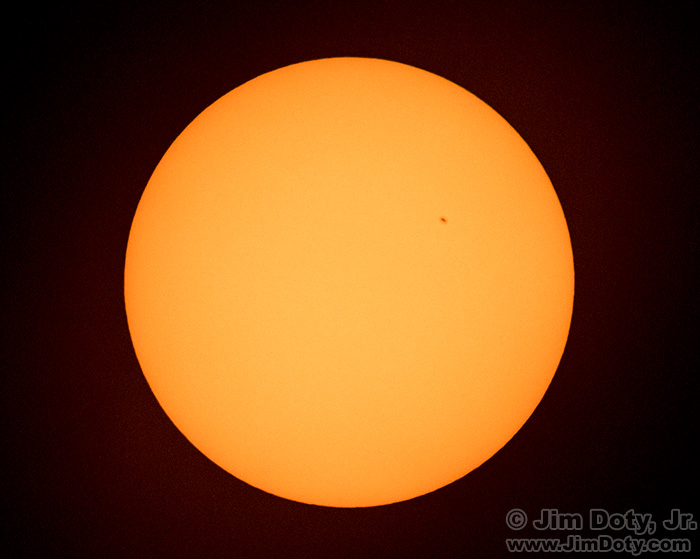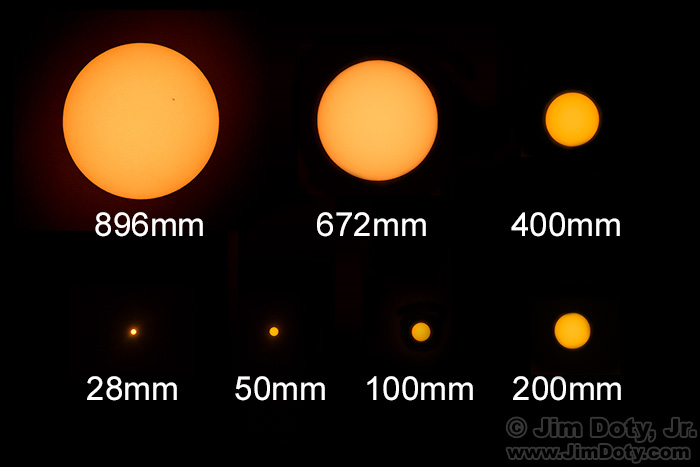The longer the focal length of your lens, the bigger the sun will be in your frame. That is why I recommend 70-300mm, 100-400mm, 150-600mm, and similar zoom lenses when photographing the sun.
Using a zoom lens also makes it easier to find the sun in the frame. Zoom to a shorter focal length like 70mm, 100mm, or 150mm to find the sun and center it in the frame. This is especially true when you are using a high density filter with the camera in Live View mode, but it is still helpful with a white light solar filter as you look through the viewfinder. Then zoom longer to photograph the sun.
Check the links below for the differences between a high density filter and a white light solar filter. If you don’t have a solar filter yet and still want to photographer the eclipse, your options are quickly vanishing. Read August 14 Update: Safe Eclipse Glasses, Binoculars, and Solar Filters For Photography and order today.
For the composite image above I used a full frame Canon 5D Mark III for the 28mm through 400mm focal lengths, using the following Canon zoom lenses: 17-40mm, 24-105mm, and 100-400mm.
For the final two focal lengths of 672mm and 896mm, I used the Canon 100-400mm Mark II lens with a Canon 1.4X Mark III teleconverter on a Canon 7D Mark II camera. The Canon 7D II has a 1.6X field of view crop, which means images look like they were photographed with a lens focal length 60% longer than on a full frame camera. A 100mm lens on a 1.6x cropped sensor camera gives you an image that looks like a 160mm lens on a full frame (24x36mm) sensor. More about the field of view crop in this article.
For the 672mm image the lens was set at a focal length of 300mm. The 1.4x teleconverter changed the focal length of 420mm. The 1.6x field of view crop gives me an equivalent focal length of 672mm.
For the 896mm image the lens was set at a focal length of 400mm. The 1.4x teleconverter makes that 560mm. The 1.6x field of view crop gives me an equivalent focal length of 896mm.
I did not crop any of the 7 images. I resized all of the images “as is” to 700x467mm, keeping the original ratio between the size of the sun and the size of the frame. I cut and paste the sun out of each separate image and dropped them into a single 700x467mm frame, maintaining all the original size relationships.
 You can, of course, crop your images to make them look bigger, but there is a limit as to how much bigger you can make the sun look based on the size of the sun in the original image. This is the 896mm image cropped to make the sun look bigger. The sunspot is more obvious than in the uncropped 896mm sun at the top.
You can, of course, crop your images to make them look bigger, but there is a limit as to how much bigger you can make the sun look based on the size of the sun in the original image. This is the 896mm image cropped to make the sun look bigger. The sunspot is more obvious than in the uncropped 896mm sun at the top.
I’ve been asked if you can photograph the sun and/or the eclipse with a smartphone and solar filter. My iPhone SE has a 4.15mm aperture which gives you a 35mm equivalent focal length of about 29mm. In terms of size in the frame the sun would look virtually identical to the 28mm focal length sun.
Links
The Great American Eclipse Series
The Great American Eclipse Series  – All of my eclipse articles are listed at this link. Check back for new articles as they appear. This is the 31st article in the series.
More Links
The Field of View Crop in DSLRs
How To Photograph the Sun (and an Eclipse) with Lee and Other High Density Solar Filters
How to Photograph the Sun (and an Eclipse) with a “White Light†Solar Filter
Practice Your Solar Eclipse Photography Skills Now!

